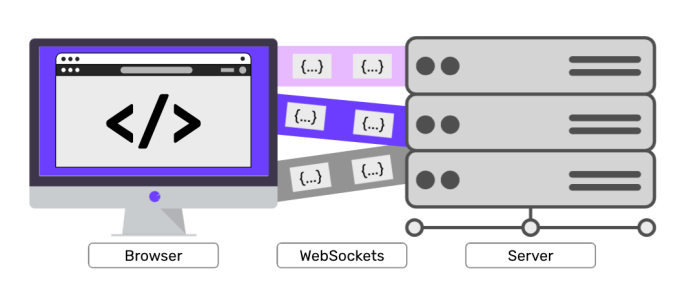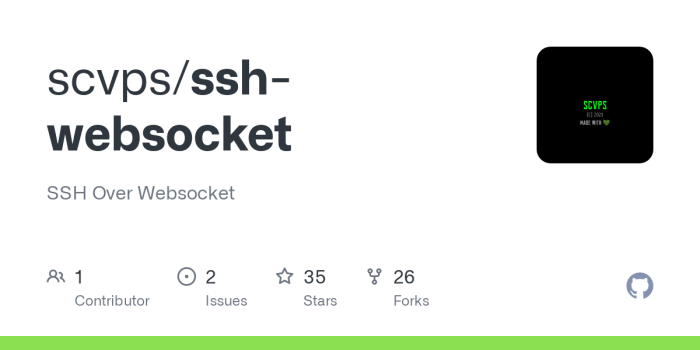SSH.SSHSlowdns.com – In the realm of remote access, the integration of WebSocket and SSH protocols has emerged as a game-changer. WebSocket SSH, a secure and real-time communication channel, has transformed the way we interact with remote systems, offering a seamless and interactive experience that rivals local connections.
With its ability to establish persistent connections, WebSocket SSH enables real-time data transmission, making it ideal for applications such as remote terminal access, data streaming, and interactive debugging. Its advantages extend beyond enhanced responsiveness, as it also boasts increased security and compatibility with modern web technologies.
WebSocket SSH Overview

WebSocket SSH is a protocol that enables secure remote access to a server over a WebSocket connection. It combines the benefits of SSH, such as encryption and authentication, with the real-time communication capabilities of WebSockets.
WebSocket SSH offers several advantages over traditional SSH connections, including:
- Improved performance: WebSockets use a persistent connection, which reduces latency and improves responsiveness.
- Cross-platform compatibility: WebSockets are supported by all major browsers, making it easy to access remote servers from any device.
- Real-time communication: WebSockets allow for real-time communication between the client and server, enabling interactive applications and data streaming.
Benefits of Real-Time Communication
Real-time communication is a key advantage of WebSocket SSH. It enables applications to send and receive data in real time, allowing for:
- Interactive shells: Users can interact with remote shells in real time, as if they were connected directly to the server.
- Data streaming: Applications can stream data from remote servers in real time, enabling real-time monitoring and visualization.
- Collaboration: Multiple users can collaborate on remote servers in real time, sharing terminals and working together on projects.
WebSocket SSH Protocols
WebSocket SSH combines the WebSocket protocol and the SSH protocol to establish secure, real-time communication over the web.
WebSocket Protocol
WebSocket is a bidirectional communication protocol that enables real-time data exchange over a single TCP connection. It allows web browsers and servers to communicate without the need for polling or long-lived HTTP connections, resulting in reduced latency and improved responsiveness.
SSH Protocol
SSH (Secure Shell) is a secure network protocol that provides encrypted communication over an insecure network. It offers features such as authentication, data encryption, and port forwarding, ensuring the confidentiality and integrity of data transmitted over the network.
Integration of WebSocket and SSH Protocols
The integration of WebSocket and SSH protocols allows for the creation of secure, real-time SSH connections over the web. This combination enables remote access to servers, terminal emulation, and other SSH-based applications from within a web browser without the need for additional software or plugins.
WebSocket SSH Implementation
WebSocket SSH enables a secure and real-time interactive shell experience over a WebSocket connection. To implement WebSocket SSH, several steps are necessary:
-
- -*Obtain a WebSocket SSH library or tool
Choose a reliable library that supports WebSocket SSH protocols and provides a stable and feature-rich implementation.
- -*Obtain a WebSocket SSH library or tool
-*Configure the server and client
Set up the server to listen for WebSocket SSH connections and configure the client to establish a secure WebSocket connection to the server.
-*Handle authentication and authorization
Implement mechanisms to authenticate and authorize users securely, such as using SSH keys or password-based authentication.
-*Establish the SSH session
Once authenticated, establish an SSH session over the WebSocket connection, allowing the client to execute commands on the server.
WebSocket SSH Libraries and Tools
Numerous WebSocket SSH libraries and tools are available, each offering unique features and capabilities:
-
- -*SockJS
A JavaScript library that provides WebSocket emulation for browsers that do not natively support WebSockets.
- -*SockJS
-*Paho.MQTT.js
A JavaScript client library for MQTT, which can be used for WebSocket SSH implementations.
-*websocket-ssh
A Python library that simplifies WebSocket SSH implementation by providing a high-level API.
-*ssh2js
A JavaScript library that enables secure SSH connections over WebSocket.
Challenges and Solutions of WebSocket SSH Implementation
Implementing WebSocket SSH involves several challenges:
-
- -*Security
Ensuring a secure connection and preventing unauthorized access is crucial. Implement robust authentication and encryption mechanisms to safeguard data transmission.
- -*Security
-*Cross-browser compatibility
WebSocket SSH libraries may not be compatible with all browsers. Consider using a library that supports multiple browsers or provides cross-browser compatibility features.
-*Performance optimization
Optimize the WebSocket connection to minimize latency and maximize data transfer speed. Utilize compression techniques and efficient data handling algorithms to enhance performance.
-*Scalability
Design the WebSocket SSH implementation to handle multiple concurrent connections and scale effectively as the number of users increases.
-*Error handling
Implement comprehensive error handling mechanisms to gracefully handle connection failures, authentication errors, and other potential issues.
WebSocket SSH Applications

WebSocket SSH is a versatile technology that finds applications in various industries, enabling secure remote access, data transfer, and automation tasks.
Remote Access and Management
WebSocket SSH allows administrators to securely access and manage remote servers from anywhere with an internet connection. This simplifies maintenance, troubleshooting, and configuration tasks, reducing downtime and improving operational efficiency.
Data Transfer
WebSocket SSH provides a secure channel for transferring large files and sensitive data between systems. Its low latency and high bandwidth capabilities make it ideal for applications involving real-time data exchange, such as financial trading or scientific research.
Automation and Scripting
WebSocket SSH enables automation of repetitive tasks through scripting. By establishing a persistent connection, scripts can be executed remotely without the need for manual intervention, streamlining processes and improving productivity.
Case Study: DevOps and Continuous Integration
In the DevOps and continuous integration (CI) workflow, WebSocket SSH plays a crucial role in automating deployment processes. It allows developers to securely connect to remote servers, execute build and test commands, and deploy code changes with ease. This automation reduces errors, improves code quality, and accelerates software development cycles.
WebSocket SSH Security Considerations

WebSocket SSH introduces security risks due to its inherent characteristics. Understanding these risks and implementing best practices is crucial for secure WebSocket SSH connections.
Encryption
Encryption is paramount for securing WebSocket SSH connections. Data transmitted over the network should be encrypted to prevent eavesdropping and unauthorized access. SSH supports various encryption algorithms, such as AES-256, which provide robust protection against brute-force attacks.
Authentication
Strong authentication mechanisms are essential to prevent unauthorized access to WebSocket SSH connections. SSH offers several authentication methods, including password-based, public-key, and multi-factor authentication. Multi-factor authentication, which combines multiple authentication factors, significantly enhances security by reducing the risk of unauthorized access even if one factor is compromised.
Access Control
Proper access control measures should be implemented to restrict access to WebSocket SSH connections only to authorized users. This can be achieved through firewalls, access control lists (ACLs), and role-based access control (RBAC) mechanisms. By limiting access to authorized users, the risk of unauthorized access and potential data breaches is minimized.
WebSocket SSH Performance Optimization
Optimizing WebSocket SSH connections is crucial for ensuring seamless and responsive remote access experiences. Several factors can impact performance, including network latency, bandwidth, and client-side processing capabilities.
Identifying Factors Affecting WebSocket SSH Performance
Network latency, the time it takes for data packets to travel between the client and server, is a significant factor. High latency can result in noticeable delays and reduced interactivity. Similarly, insufficient bandwidth can limit the amount of data that can be transferred, leading to slow data transfer speeds and potential interruptions.
Additionally, client-side processing capabilities, such as the speed of the client’s CPU and memory, can affect performance, especially when handling complex data or performing computationally intensive tasks.
Techniques for Optimizing WebSocket SSH Connections
To optimize WebSocket SSH connections, several techniques can be employed:
- Reducing Network Latency: Minimizing network latency involves optimizing the physical network infrastructure, such as using high-speed cables, routers, and switches. Additionally, reducing the distance between the client and server can help decrease latency.
- Increasing Bandwidth: Ensuring sufficient bandwidth is crucial for supporting high-volume data transfers. Upgrading to faster network connections, such as fiber-optic cables or dedicated leased lines, can significantly increase bandwidth.
- Optimizing Client-Side Processing: Utilizing efficient client-side code can improve performance. Optimizations include using faster algorithms, reducing unnecessary data processing, and leveraging hardware acceleration capabilities when available.
Impact of Network Latency and Bandwidth
Network latency and bandwidth have a direct impact on WebSocket SSH performance. High latency can introduce noticeable delays in data transmission, making interactive operations such as command execution or real-time data streaming less responsive. Insufficient bandwidth, on the other hand, can limit the rate at which data can be transferred, leading to slower file transfers or video streaming.
Understanding the impact of these factors is essential for optimizing WebSocket SSH connections.
WebSocket SSH Troubleshooting
WebSocket SSH connections can encounter various issues during establishment or operation. Understanding the common problems and their solutions is crucial for maintaining a stable and secure connection.
Identifying WebSocket SSH Issues
Common WebSocket SSH issues include:
-
- -*Connection failures
Inability to establish a WebSocket connection or authenticate with the SSH server.
- -*Connection failures
-*Data transmission errors
Loss or corruption of data during transmission over the WebSocket connection.
-*Performance degradation
Slow or intermittent data transfer, leading to a degraded user experience.
-*Security vulnerabilities
Exposure of sensitive data or unauthorized access to the SSH server.
Troubleshooting WebSocket SSH Problems
To troubleshoot WebSocket SSH problems, follow these steps:1.
-
- -*Verify the WebSocket connection
Ensure that the WebSocket connection is established successfully and that the SSH server is accessible.
- 2.
- -*Verify the WebSocket connection
-*Check the SSH server configuration
Confirm that the SSH server is configured to allow WebSocket connections and that the necessary ports are open.
-
- 3.
-*Inspect the WebSocket client code
Review the WebSocket client code for any errors or inconsistencies that may be causing the issue.
-
- 4.
-*Use debugging tools
Utilize browser debugging tools or network monitoring software to identify any errors or anomalies in the WebSocket traffic.
-
- 5.
-*Handle errors gracefully
Implement proper error handling mechanisms in the WebSocket client to handle connection failures or data transmission errors gracefully.
Error Handling
Proper error handling is essential for managing WebSocket SSH issues. Consider the following strategies:
-
- -*WebSocket error events
Monitor WebSocket error events to detect and handle connection failures or data transmission errors.
- -*WebSocket error events
-*Custom error handlers
Define custom error handlers to provide specific error messages and perform necessary actions.
-*Logging and reporting
Log WebSocket errors and report them to the appropriate channels for further analysis and resolution.
WebSocket SSH Future Trends
WebSocket SSH technology continues to evolve, offering exciting advancements and potential applications. Let’s explore some emerging trends and future use cases.
One significant trend is the integration of WebSocket SSH with cloud computing platforms. This integration enables secure and efficient remote access to cloud-based resources, allowing developers and administrators to manage and monitor cloud infrastructure from any location.
Enhanced Security Features
- Advanced encryption algorithms: WebSocket SSH will incorporate stronger encryption protocols to ensure data privacy and integrity.
- Multi-factor authentication: Integration with multi-factor authentication mechanisms will provide an additional layer of security.
- Improved key management: Efficient key management techniques will simplify key generation, storage, and distribution.
Integration with Other Technologies
- WebAssembly: WebSocket SSH will leverage WebAssembly to enhance performance and portability.
- Blockchain: Integration with blockchain technology will enable secure and transparent access control.
- Artificial Intelligence: AI-powered features will improve threat detection and response capabilities.
Emerging Use Cases
- Secure Remote Collaboration: WebSocket SSH will facilitate seamless remote collaboration among team members, allowing real-time access to shared resources.
- IoT Device Management: Integration with IoT devices will enable secure remote management and monitoring of IoT infrastructure.
- Edge Computing: WebSocket SSH will support secure remote access and management of edge devices, facilitating real-time data processing and decision-making.
WebSocket SSH Comparison with Alternatives
WebSocket SSH stands out among remote access solutions due to its unique advantages and versatility. Here’s how it compares with other alternatives:
Remote Desktop Protocol (RDP)
* RDP offers a graphical user interface (GUI) for remote access, allowing users to interact with the remote desktop as if they were physically present.
- It’s suitable for tasks that require high bandwidth, such as video editing or running resource-intensive applications.
- However, RDP has security vulnerabilities and can be susceptible to attacks if not properly configured.
Virtual Network Computing (VNC)
* VNC also provides a GUI-based remote access experience, allowing users to view and control the remote desktop.
- It’s lightweight and cross-platform, making it accessible from various devices.
- However, VNC can be slower than RDP and is not as secure, making it less suitable for sensitive data or applications.
Secure Shell (SSH)
* SSH is a command-line-based remote access protocol that provides secure and encrypted communication over a network.
- It’s widely used for managing servers and accessing remote systems.
- While SSH is highly secure, it lacks a graphical interface and can be challenging for users unfamiliar with command-line operations.
WebSocket SSH Advantages
* WebSocket SSH combines the advantages of both SSH and WebSockets, offering a secure and interactive remote access experience.
- It’s ideal for scenarios where a GUI is required, such as web-based terminals or remote desktop applications.
- WebSocket SSH is also lightweight and cross-platform, making it accessible from any device with a web browser.
WebSocket SSH Disadvantages
* WebSocket SSH may not be as fast as RDP for high-bandwidth tasks due to its underlying WebSocket technology.
It’s also important to ensure that the WebSocket SSH implementation is secure and properly configured to mitigate potential vulnerabilities.
Best Use Cases for WebSocket SSH
WebSocket SSH is the best choice for remote access scenarios where:* A GUI is required for user interaction
- Security is paramount
- Cross-platform accessibility is essential
- Bandwidth requirements are not excessively high
WebSocket SSH Resources
WebSocket SSH is a powerful tool that enables secure remote access to SSH servers over a WebSocket connection. To delve deeper into this technology, we present a comprehensive list of resources that cater to various learning preferences.
Documentation
*
- MDN Web Docs: WebSocket Secure Shell (SSH)
– A concise overview of WebSocket SSH. - IETF Internet-Draft: WebSockets Over SSH
– A technical specification defining the WebSocket SSH protocol.
Tutorials
*
- DigitalOcean: How To Use WebSockets to Access an SSH Server
– A step-by-step guide to setting up and using WebSocket SSH. - Codecademy: Learn WebSocket SSH
– An interactive tutorial covering the basics of WebSocket SSH.
Community Forums
*
- Stack Overflow: WebSocket SSH
– A platform for asking and answering questions related to WebSocket SSH. - GitHub Discussions: WebSocket SSH
– A forum for discussing WebSocket SSH projects and sharing knowledge.
Research Papers
*